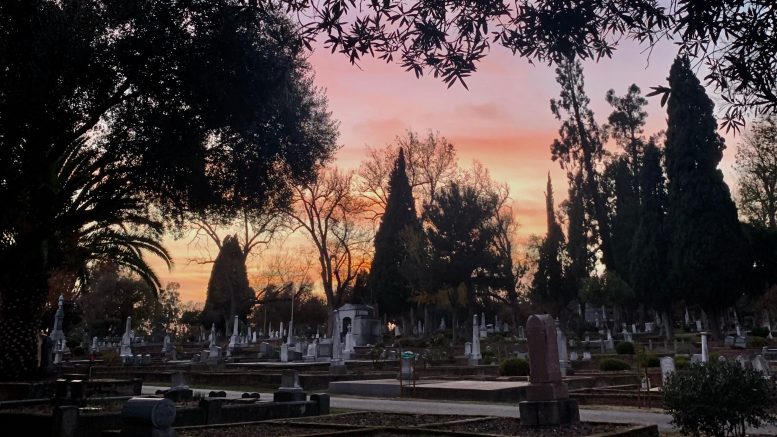By Scott Thomas Anderson
Winter twilights over Broadway often reveal a smoldering rouge on the clouds that’s half-radiating against the blue cold of the coming dark. It’s a sight that gradually returns with the chilliest part of the season, creating a mesmerizing blaze in our Yuletide sundowns.
This spectral painting on the night is a bit eerie in Sacramento’s Old City Cemetery, where many rest who would have glimpsed that same strange spell during lost Noels of generations past. Settlers celebrated the holiday on the edge of this burial ground as far back as 170 years ago; and near the cemetery’s front gates stand a pair of headstones that call back to the very worst of those winters – two silent reminders of the hardest Christmas season that Sacramento ever endured.
In December of 1850, the city was experiencing the tail end of a catastrophic cholera outbreak that had started two months before. It’s believed to have originated on the banks of the river, with a sick man who’d just debarked a ship gruesomely shuddering to death near the rickety docks and tilted pilings.
On Oct. 20, city leaders were informed that “the Blue Death” had arrived in their avenues. They could be forgiven for wondering if Sacramento was under some kind of curse: It had just been rocked by the violent “squatter riots,” which included Hardin Bigelow – the city’s first mayor – being shot and badly wounded. That blur of gunplay at the corner of J and 4th streets left five other men dead, including Sacramento’s first accessor, J.W. Woodward.
The following day, the city’s first Sheriff, Joseph McKinney, was pulled into a second gun battle and sent to the waiting gold fields in the sky.
Hardin Bigelow wasn’t in Sacramento when cholera first landed on its riverbanks. He was still recovering in San Francisco from his gunshot injuries.
A retrospective by Ian A. Stewart in California Freemason examines how Sacramento’s remaining public officials made a mistake as they tried to respond to the sudden epidemic. Stewart details how the leaders “ordered the mandatory burning of all garbage (under penalty of a crippling $500 fine for any resident or business out of compliance), hoping to eradicate the squalid grime believed to carry the disease. (The order backfired, leading only to an even greater tainting of the water supply.)”
Stewart also notes an observation that was made at the time by Pierre Barlow Cornwall, that “almost overnight” the city’s cemeteries “appeared to be newly ploughed fields.”
By the end of October, Sacramentans were dying in droves. A newspaper called The Sacramento Transcript published a warning – darkly enough – on Halloween day, 1850.
“The patient grows weak, his whole frame seems unstrung, and it is with difficulty he can muster courage to move,” the reporter noted. “He now sees objects enveloped in mist, there is a throbbing or drumming sensation in the ears; objects appear to be whirling and running in every direction; he grows dizzy, sickens at the stomach … the blood ceases to pass through the capillary vessels; the nails turn blue; the glow of health leaves the cheeks, and they assume the blue hue; the eyes are sunken, and gaze with a vacant stare on surrounding objects.”
All through that fall and into mid-December, a group of doctors selflessly attempted to keep the cholera spread from wiping out the entire city. Seventeen of those physicians ultimately gave their lives to do that. The oldest of them was Dr. Metcalf, who was 60. The youngest were doctors Henry F. Herr, R.H. Hale, W. Carpenter and T.P.N. Whittaker, all of whom were 26.
Hardin Bigelow, still languishing in the Bay, also died of cholera as it ran through Northern California.
One of the most hard-working doctors during the outbreak, John Frederick Morse, somehow survived the hellish holiday, only to later die during the Christmas season of 1874.
Hardin Bigelow’s body was eventually brought back to the city that he helped found. Bigelow was interred there, along with the casualty doctors and some 800 other disease victims, in what is today’s old city cemetery. Well – kind of. The boundaries of the cemetery changed over time, and the sea of bodies from the 1850 cholera epidemic now sleeps somewhere under Broadway Avenue.
Eventually, a large headstone for Bigelow was erected near the front cemetery gates. In 1977, the Sacramento El Dorado Medical Society Historical Committee put up a monument to all the doctors who’d perished in pursuit of their profession during that season of cholera. It’s just a few feet away from Mayor Bigelow’s marker. Together, these two stones bear witness to a Christmastime when Sacramentans tried to cope with having lost nearly 10 percent of the city’s population in less than three months. It is an unimaginable blow to the psyche of a fledgling city, yet the rest of the elegant cemetery – and modern surrounding streets – are proof that those settlers somehow kept mentally and spiritually soldiering on.
Scott Thomas Anderson is also the writer-producer of the documentary podcast series ‘Drinkers with Writing Problems,’ Episode 6 of which is partly about this era in Sacramento’s history.


Be the first to comment on "1850: Sacramento’s most forlorn Christmas"